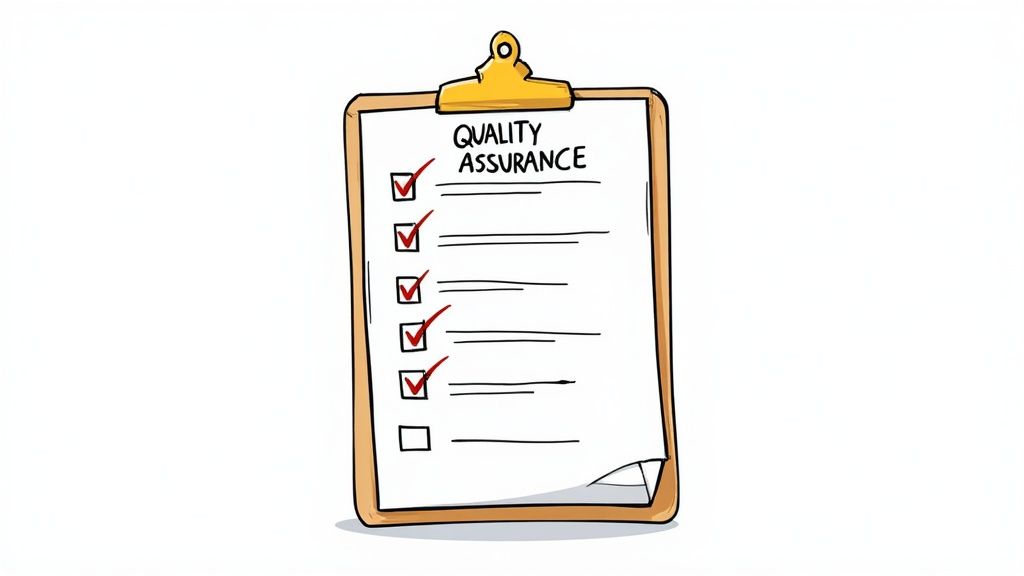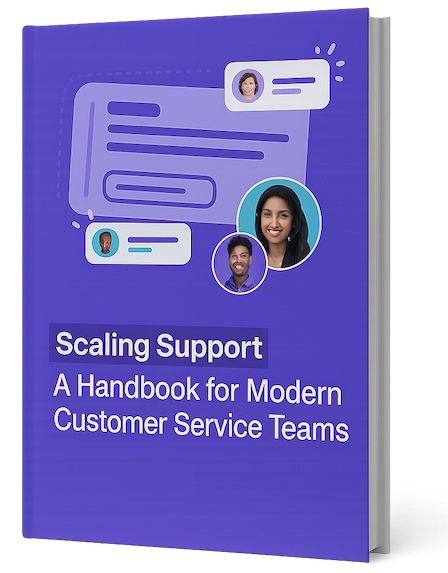Understanding Modern Customer Service Expectations

The approach to customer service quality has shifted dramatically in recent years. As more interactions happen online, businesses need fresh solutions to meet customer needs. People expect a personal touch when getting help – in fact, 82% of customer service leaders expect personalization demands to grow by 2025. Just as telling, 88% of consumers say service matters just as much as the actual product. See the full research on customer service trends.
Adapting to Change: Practical Strategies
To keep up with these new demands, companies should focus on smart, proactive approaches. Here's what works:
- Use Data Wisely: Study customer patterns to understand what they need before they ask
- Create Flexible Support: Build systems that can give quick, personalized help
A great example is IKEA's chatbot Billie, which now handles nearly half of all support requests, freeing up human agents to tackle more complex issues.
Real-World Success Stories
Many organizations are finding creative ways to meet modern service expectations. Take banking – some institutions now use AI for routine transactions while keeping human agents available for detailed financial discussions. This approach helps ensure customers get the right level of expertise when they need it.
Building Better Service Systems
To stay ahead of customer needs, successful companies:
- Train for Empathy: Help support teams handle emotionally complex situations
- Keep Learning: Get regular feedback to improve how you help customers
The best companies know that customer service quality gives them an edge over competitors. By understanding and meeting these new expectations head-on, they turn great service into lasting success.
The Speed Factor: Meeting Response Time Expectations

Being responsive is crucial for customer service success. Recent data shows that 65% of customers want faster responses than they did five years ago, with 72% expecting a reply within just 30 minutes. This puts First Response Time (FRT) at the center of measuring customer satisfaction. Learn more about modern customer service expectations.
Smart Response Strategies
Companies are finding ways to speed up service without sacrificing quality. Here are practical approaches that work:
- Queue Management Techniques: Smart ticket sorting to cut wait times
- Intelligent Routing Systems: Getting requests to the right agent quickly
- Efficient Resource Allocation: Having enough staff during busy periods
For instance, online retailer Zappos uses advanced queue systems to minimize customer wait times while maintaining high service standards.
Quality Plus Speed
Fast responses shouldn't come at the cost of good solutions. Leading support teams focus on:
- Training Empowers Agents: Teaching skills for quick, effective problem-solving
- Feedback Systems Are in Place: Using customer input to spot and fix service bottlenecks
Key Success Metrics
Teams need clear ways to track their speed and quality. Here are the essential numbers to watch:
| Metric | Definition |
|---|---|
| First Response Time (FRT) | Time taken to respond to a customer for the first time. |
| Average Handling Time (AHT) | Average duration to resolve a customer inquiry. |
| First Call Resolution (FCR) | Percentage of issues resolved on the first interaction. |
By focusing on these metrics and strategies, companies can deliver the quick, helpful service that customers want while building long-term loyalty.
Building a Customer-Centric Service Culture
Creating outstanding customer service starts with building a customer-centric culture throughout your organization. By studying successful companies and their practices, we can identify practical approaches that deliver results.
Key Strategies for Customer-Centric Transformation
Making your organization truly customer-focused takes more than just nice words – it requires concrete actions. Here are essential elements to focus on:
- Hiring for Service Skills: Look for people with natural empathy and problem-solving abilities
- Ongoing Training: Create regular programs to strengthen customer interaction capabilities
- Recognition Systems: Create ways to reward great service. For example, Ritz-Carlton gives staff discretionary funds to fix customer issues on the spot.
Overcoming Resistance to Change
When shifting to put customers first, you may face internal pushback. Here's how to handle it:
- Get Leaders On Board: Make sure executives actively support and model the customer-first mindset
- Clear Communication: Share the reasons and benefits behind changes openly
- Step-by-Step Rollout: Make changes gradually to help people adjust
Making Customer Focus Part of Daily Work
The customer-first approach needs to show up in everyday tasks:
- Give Staff Authority: Let employees make decisions to help customers quickly
- Regular Customer Input: Use tools like SupportMan to track how customers feel about service quality
Measuring Progress
Track these key metrics to see how your culture is changing:
| Metric | What It Shows |
|---|---|
| Customer Satisfaction Score | How happy customers are overall |
| Employee Engagement Rate | How committed staff are to customer service goals |
| Net Promoter Score (NPS) | Whether customers would recommend you to others |
By focusing on these core areas, companies can build lasting customer service excellence that scales with growth. Just look at companies like Zappos – this approach leads to long-term success and loyal customers.
Using Technology to Improve Service Quality

The quality of customer service depends heavily on smart use of technology. AI tools and automation help companies serve customers better by predicting needs, handling routine tasks, and giving human agents more time to focus on complex issues that need a personal touch.
Making Better Decisions with AI Analytics
Tools like OpenText Contact Center Analytics AutoScore analyze 100% of customer interactions, rather than just random samples. This lets companies pinpoint exactly where human agents make the biggest impact. For example, speech analysis helps personalize agent training to create consistently great customer experiences.
Balancing Automation with Human Connection
Automated systems handle basic tasks so agents can focus on situations needing empathy and emotional intelligence. Tools like SupportMan, which brings customer feedback from Intercom into Slack, help teams spot and address issues quickly. This creates a cycle of constant improvement.
Key Questions When Choosing Technology
Consider these factors when adding new tools:
- Purpose: Does it solve a specific service challenge?
- Integration: Will it work smoothly with current systems?
- Growth: Can it adapt as your needs change?
- Results: How will you measure its impact?
Steps for Successful Technology Rollout
Adding new tools requires careful planning:
- Team Input: Get feedback from everyone involved
- Clear Training: Help staff understand and use tools effectively
- Gradual Launch: Start small and expand based on results
By following these guidelines, companies can use technology to strengthen customer connections while keeping the human element strong. The right mix of tools and training helps teams consistently deliver excellent service.
With thoughtful implementation, technology makes it easier for support teams to do their best work and create remarkable customer experiences.
Measuring and Improving Service Performance
High-quality customer service requires methodical measurement and continuous refinement. Let's explore how modern teams track and improve their support quality through data-driven methods and systematic feedback collection.
Key Metrics for Service Quality
The cornerstone metric for service quality is First Call Resolution (FCR), which shows how often issues are resolved in a single interaction. Teams should aim for an FCR rate above 70% since this correlates with lower costs and increased satisfaction.
To get a complete view, successful teams track multiple metrics:
- Customer Effort Score (CES): Shows how simple or difficult customers find your support process
- Net Promoter Score (NPS): Reveals customer loyalty and likelihood to recommend
- Customer Satisfaction Score (CSAT): Measures overall satisfaction with service quality
These metrics work best when woven into daily operations to guide improvements.
Getting Meaningful Feedback
Regular feedback helps spot issues early and drives meaningful changes. Here are proven feedback methods:
- Post-Interaction Surveys: Quick pulse checks after each customer interaction
- Focus Groups: In-depth discussions with customer groups
- Social Media Monitoring: Active tracking of public comments and sentiment
Each method reveals different insights that help shape a better service experience.
Using Data to Get Ahead of Issues
Modern support teams use AI-powered analytics to spot potential problems before they affect customers. This proactive approach helps maintain consistently excellent service.
| Analysis Tool | Key Benefit |
|---|---|
| Predictive Analytics | Spots potential issues early |
| Sentiment Analysis | Shows real-time customer feelings |
Building a Culture of Improvement
Great service requires ongoing refinement through:
- Clear Service Goals: Define what great support looks like for your team
- Regular Training: Keep teams current on best practices
- Performance Reviews: Use tools like SupportMan to track progress and integrate feedback
By focusing on data, gathering regular feedback, and committing to improvement, teams can steadily enhance their customer service quality and build lasting customer relationships.
Training and Empowering Service Teams

The quality of customer service starts with well-trained support teams. When employees have the right skills and support, they excel at handling complex customer needs. Here's how leading companies build teams that consistently deliver great service.
Key Training Strategies for Service Excellence
Support teams need focused training in several core areas:
- Emotional Intelligence: Help team members understand customer feelings and respond with empathy
- Problem-Solving Skills: Give employees tools to find solutions quickly and effectively
- Decision-Making Abilities: Build confidence through real-world practice scenarios
Many organizations find success with role-playing exercises that let employees practice handling different customer situations firsthand.
Coaching and Team Development Techniques
Ongoing development keeps service quality high through:
- Regular Feedback Sessions: Use tools like SupportMan to get customer feedback directly in Slack for quick improvements
- Group Learning Workshops: Bring teams together to share knowledge and solve problems
- Individual Growth Plans: Provide one-on-one coaching matched to each person's needs
Just as sports teams improve through practice and feedback, service teams get better when they have chances to learn and grow together.
Measuring and Sustaining Team Performance
Teams need clear ways to track how well they're serving customers:
| Framework | Focus |
|---|---|
| Peer Reviews | Encourages accountability and knowledge sharing |
| Goal-Oriented Metrics | Aligns team efforts with specific service objectives |
| Balanced Scorecards | Tracks a combination of qualitative and quantitative data |
Regular review of these metrics helps teams keep improving their service quality.
Support Tools That Make a Difference
Tools like SupportMan help teams track feedback and performance in one place, making it easier to align service with what customers expect. This helps create a culture where teams are always working to serve customers better.
See how SupportMan can help your support team with real-time feedback and analytics – try it free with no credit card required.


